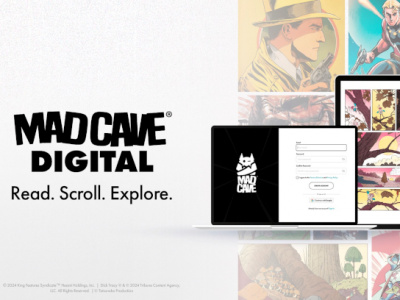 Rob Salkowitz (@robsalk) is a business futurist and author of several books including Comic-Con and the Business of Pop Culture. This is his first column for ICv2.
Rob Salkowitz (@robsalk) is a business futurist and author of several books including Comic-Con and the Business of Pop Culture. This is his first column for ICv2. What makes a comic popular? A great creative team? A hot media tie-in? A gorilla on the cover? What was once guesswork is now becoming science, thanks to Big Data.
Comics have always been driven by sales, but in the early days, publishers had to wait for months to get final results on which to base editorial decisions. Back in 1938-39, it took DC more than a year and a half to figure out they should feature Superman on the cover of every issue of Action Comics. Marvel didn’t give Spider-Man his own book until they saw the spike in sales for the final issue of Amazing Fantasy and realized, belatedly, they had a hit on their hands.
Oh how far we’ve come.
Yesterday’s information-poor world has been supplanted by Big Data: the flood of bits generated as a byproduct of our digital lifestyle. Big Data doesn’t just refer to the volume of information; it suggests a mode of analysis that, properly applied, can predict future outcomes better than the gut instincts of experts. Just look at how the quantitative forecasts of New York Times political analyst Nate Silver consistently outperform the prognostications of veteran pundits.
Now that kind of thinking is starting to permeate the world of pop culture and entertainment.
Netflix famously used analytics to identify the combination of creative talent, plot and structure necessary to make House of Cards a hit with its audience. Hulu is undertaking the same strategy with its original programming, relying on the information it has gathered about the habits of viewers and visitors to its website to promote original series to specific target audiences at the exact moment when they are likely to be receptive to suggestion.
Does that sound creepy? That term comes up a lot in conversations about Big Data, even among professionals. Even though most Big Data aggregators don’t track individual behavior or spy directly on users, there’s something disconcerting about knowing more about a person’s tendencies and behaviors than that person knows themselves. Just ask Target, which got into hot water last year when its analytics identified customers in the early stages of pregnancy and started sending them promotional offers for baby items, sometimes before the expectant mothers had announced the news to their families. So, yeah. Creepy.
But if data is creepy, ignorance can be even worse.
In the world of comics, we don’t know much about what kind of data is being collected or how it’s being used. Direct market sales figures remain a black box, with reader preferences filtered through the lens of retailer orders, then distorted again by the nature of the direct market’s self-selected audience. Diamond’s POS system provides information about what is going through the cash register, but not much about who is actually buying. Every so often, a publisher releases the results of a demographic study on readership.
That leaves a lot of dots to connect, and fools rush in where facts fear to tread. Without rigorous, end-to-end sales data reflecting the true voice of the customer, you are left with the nexus of assumptions, preconceived notions, personal agendas and industry politics that gave rise to to decades of editorial decisions ranging from the head-scratching to the outrageous.
However, there is now a new, richer source of data about comics readers, growing in scale every month. Yes comiXology, with your 100+ million downloads, I’m looking at you.
Digital comics represent something like 10-15% of the market, but their rapid growth gives reason to believe they are a good proxy for the comics audience at large – both direct-market and the broader mainstream. Readership numbers on many books are high enough to provide statistically significant samples, and the nature of the digital experience allows much deeper insights into reader behavior.
Every time readers obtain comics through comiXology, there is not only a record of the transaction, but potentially a lot of information about exactly how, when and where they are reading that comic, what else they are reading, what they’ve browsed or previewed and decided against, and whether or not they purchase additional issues. When aggregated with anonymous demographic data – for example, credit card information associated with the account – you get a much clearer picture than we’ve ever had of the comics audience.
There is no evidence that any of this is happening yet. ComiXology has consistently articulated firm support for user privacy and is reluctant to discuss any possible use of its data for these kinds of analytics. You don’t hear Marvel, DC or any of the company’s other partners talking about it either. There is a reputational downside to playing fast and loose with customer data that businesses clearly want no part of, and it’s easy to see why. When Big Data starts looking like Big Brother, everyone loses.
The thing is, data-based decision-making is coming sooner or later and it’s not all bad. There are real benefits to readers, fans and creators as well as publishers in grounding editorial and creative conversations in real market data instead of supposition and prejudice. Consider these possible conversations:
- "Hey, mister editor, did you know nearly 60% of the readers who finished issue 15 immediately went to browse back issues and collections for the related mini-series, and 38% of them ended up buying at least one issue. You might want to encourage your creative team to tell more stories like that."
- "You lost 75% of your female readers after issue 2 of your new series, and fully 45% of them gave up after page 8. Maybe you want to take a look at that page and see what went wrong."
- "That artist you wrote off as too old is actually more popular with 18-22 year old readers than your new, hot, flavor-of-the-month."
- "Last month, 70% of mobile downloads for Iron Man titles in the LA area took place within half a mile of theatres showing the movie, and data strongly indicate that people were reading the comics while waiting in line for tickets. Maybe you want to consider some kind of cross-promotion to drive up readership."
The opinions expressed in this column are solely those of the writer, and do not necessarily reflect the views of the editorial staff of ICv2.com.







